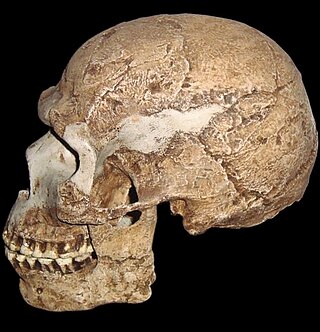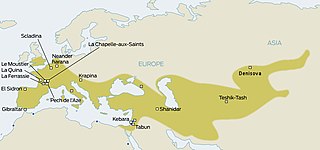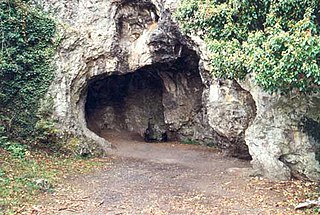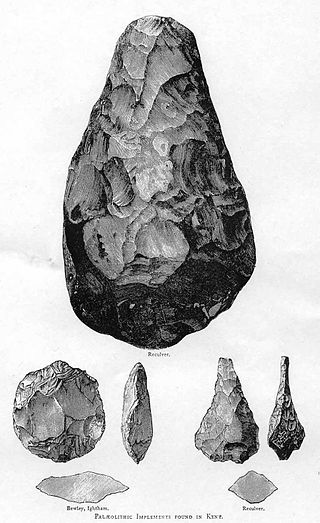Related Research Articles

Early modern human (EMH) or anatomically modern human (AMH) are terms used to distinguish Homo sapiens that are anatomically consistent with the range of phenotypes seen in contemporary humans, from extinct archaic human species. This distinction is useful especially for times and regions where anatomically modern and archaic humans co-existed, for example, in Paleolithic Europe. Among the oldest known remains of Homo sapiens are those found at the Omo-Kibish I archaeological site in south-western Ethiopia, dating to about 233,000 to 196,000 years ago, the Florisbad site in South Africa, dating to about 259,000 years ago, and the Jebel Irhoud site in Morocco, dated about 315,000 years ago.

The Mousterian is an archaeological industry of stone tools, associated primarily with the Neanderthals in Europe, and to the earliest anatomically modern humans in North Africa and West Asia. The Mousterian largely defines the latter part of the Middle Paleolithic, the middle of the West Eurasian Old Stone Age. It lasted roughly from 160,000 to 40,000 BP. If its predecessor, known as Levallois or Levallois-Mousterian, is included, the range is extended to as early as c. 300,000–200,000 BP. The main following period is the Aurignacian of Homo sapiens.
The Middle Paleolithic is the second subdivision of the Paleolithic or Old Stone Age as it is understood in Europe, Africa and Asia. The term Middle Stone Age is used as an equivalent or a synonym for the Middle Paleolithic in African archeology. The Middle Paleolithic broadly spanned from 300,000 to 30,000 years ago. There are considerable dating differences between regions. The Middle Paleolithic was succeeded by the Upper Paleolithic subdivision which first began between 50,000 and 40,000 years ago. Pettit and White date the Early Middle Paleolithic in Great Britain to about 325,000 to 180,000 years ago, and the Late Middle Paleolithic as about 60,000 to 35,000 years ago. The Middle Paleolithic was in the geological Chibanian and Late Pleistocene ages.

Neanderthals became extinct around 40,000 years ago. Hypotheses on the causes of the extinction include violence, transmission of diseases from modern humans which Neanderthals had no immunity to, competitive replacement, extinction by interbreeding with early modern human populations, natural catastrophes, climate change and inbreeding depression. It is likely that multiple factors caused the demise of an already low population.

Spy Cave is located in Wallonia near Spy in the municipality of Jemeppe-sur-Sambre, Namur Province, Belgium above the left bank of the Orneau River. Classified as a premier Heritage site of the Walloon Region, the location ranks among the most significant paleolithic sites in Europe. The cave consists of numerous small chambers and corridors.

Feldhofer 1 or Neanderthal 1 is the scientific name of the 40,000-year-old type specimen fossil of the species Homo neanderthalensis, discovered in August 1856 in a German cave, the Kleine Feldhofer Grotte, in the Neandertal valley, 13 km (8.1 mi) east of Düsseldorf. In 1864, the fossil's description was first published in a scientific magazine and officially named.

Early human migrations are the earliest migrations and expansions of archaic and modern humans across continents. They are believed to have begun approximately 2 million years ago with the early expansions out of Africa by Homo erectus. This initial migration was followed by other archaic humans including H. heidelbergensis, which lived around 500,000 years ago and was the likely ancestor of Denisovans and Neanderthals as well as modern humans. Early hominids had likely crossed land bridges that have now sunk.

The Neanderthal Museum is a museum in Mettmann, Germany. It was established in 1996. Located at the site of the first Neanderthal man discovery in the Neandertal, it features an exhibit centered on human evolution. The museum was constructed in 1996 to a design by the architects Zamp Kelp, Julius Krauss and Arno Brandlhuber and draws about 170,000 visitors per year. The museum also includes an archaeological park on the original discovery site, a Stone Age workshop, as well as an art trail named "human traces". All signs in the museum as well as the audio guide offered by the museum are available in German and English.

The Grotte du Renne is one of the many caves at Arcy-sur-Cure in France, an archaeological site of the Middle/Upper Paleolithic period in the Yonne departement, Bourgogne-Franche-Comté. It contains Châtelperronian lithic industry and Neanderthal remains. Grotte du Renne has been argued to provide the best evidence that Neanderthals developed aspects of modern behaviour before contact with modern humans, but this has been challenged by radiological dates, which suggest mixing of later human artifacts with Neanderthal remains. However, it has also been argued that the radiometric dates have been affected by post-recovery contamination, and statistical testing suggests the association between Neanderthal remains, Châtelperronian artefacts and personal ornaments is genuine, not the result of post-depositional processes.

The oldest undisputed examples of figurative art are known from Europe and from Sulawesi, Indonesia, dated about 35,000 years old . Together with religion and other cultural universals of contemporary human societies, the emergence of figurative art is a necessary attribute of full behavioral modernity.

Jean-Jacques Hublin is a French paleoanthropologist. He is a professor at the Max Planck Society, Leiden University and the University of Leipzig and the founder and director of the Department of Human Evolution at the Max Planck Institute for Evolutionary Anthropology in Leipzig, Germany. He is best known for his work on the Pleistocene hominins, and on the Neandertals and early Homo sapiens, in particular.
The multiregional hypothesis, multiregional evolution (MRE), or polycentric hypothesis is a scientific model that provides an alternative explanation to the more widely accepted "Out of Africa" model of monogenesis for the pattern of human evolution.

Neanderthals, also written as Neandertals, are an extinct species or subspecies of archaic humans who lived in Eurasia until about 40,000 years ago. The reasons for Neanderthal extinction are disputed. Theories for their extinction include demographic factors such as small population size and inbreeding, competitive replacement, interbreeding and assimilation with modern humans, climate change, disease, or a combination of these factors.
Gibraltar 2, also known as Devil's Tower Child, represented five skull fragments of a male Neanderthal child discovered in the British Overseas Territory of Gibraltar. The discovery of the fossils at the Devil's Tower Mousterian rock shelter was made by archaeologist Dorothy Garrod in 1926. It represented the second excavation of a Neanderthal skull in Gibraltar, after Gibraltar 1, the second Neanderthal skull ever found. In the early twenty-first century, Gibraltar 2 underwent reconstruction.

Scladina, or Sclayn Cave, is an archaeological site located in Wallonia in the town of Sclayn, in the Andenne hills in Belgium, where excavations since 1978 have provided the material for an exhaustive collection of over thirteen thousand Mousterian stone artifacts and the fossilized remains of an especially ancient Neanderthal, called the Scladina child were discovered in 1993.

Trou de l’Abîme also known as La caverne de l'Abîme and Couvin Cave is a karst cave located in Wallonia on the right bank of the Eau Noire river in the center of Couvin, Belgium, in Namur province. During various archaeological excavations of sediment deposits, Mousterian artefacts and a Neanderthal molar were discovered.

Okladnikov Cave is a paleoanthropological site located in the foothills of the Altai Mountains in Soloneshensky District, Altai Krai in southern Siberia, Russia. The cave faces south and is located on a Devonian karst escarpment, lying about 14 metres (46 ft) above the left bank of the Sibiryachikha River valley below; the river itself is a tributary of the Anuy River.

The Goyet Caves are a series of connected caves located in Wallonia in a limestone cliff about 15 m (50 ft) above the river Samson near the village of Mozet in the Gesves municipality of the Namur province, Belgium. The site is a significant locality of regional Neanderthal and European early modern human occupation, as thousands of fossils and artifacts were discovered that are all attributed to a long and contiguous stratigraphic sequence from 120,000 years ago, the Middle Palaeolithic to less than 5.000 years ago, the late Neolithic. A robust sequence of sediments was identified during extensive excavations by geologist Edouard Dupont, who undertook the first probings as early as 1867. The site was added to the Belgian National Heritage register in 1976.
Apidima Cave is a complex of five caves four small caves located on the western shore of Mani Peninsula in Southern Greece. A systematic investigation of the cave has yielded Neanderthal and Homo sapiens fossils from the Palaeolithic era.
References
- Establishing the leading Scientific Network on Neanderthal research - TNT Final Report (May 2006) PDF [ permanent dead link ]
- Gröning, F. et al. (2005): TNT – The Neanderthal Tools: Providing an Online Database and Collaboration Platform for Neanderthal Research In: Archäologie und Computer 2005. Workshop 10, pp. 1–10 PDF
- Semal, P. et al. (2004) TNT: The Neanderthal Tools. In, K. Chain et al. (Hg.): The 5th International Symposium on Virtual Reality, Archaeology and Cultural Heritage VAST, pp. 1–2 PDF
- Semal, P. et al. (2005): Numérisation des restes humains néandertaliens belges - Préservation patrimoniale et exploitation scientifique In: Notae Prehistoricae 25–2005, pp. 25–38 PDF
- Semal, P. (2006): Neandertal devient numérique, In: Les Dossiers De La Recherche Nº 24, AOÛT 2006, pp. 18–19 PDF
- Veith, S. (2006): Unearthing the Neandertal, digitally In: Biophotonics International Vol.13, pp. 84–85
- Weniger, G.-C. et al. (2005) NESPOS. A new scientific online platform . In: The World is in your eyes. Computer Applications in Archaeology 2005, Tomar. PDF